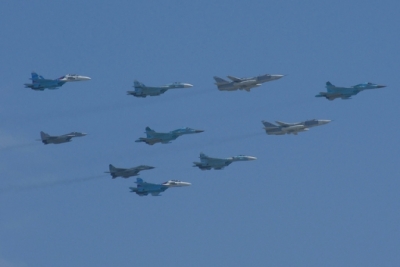 NATO detected and monitored four groups of Russian military aircraft conducting significant military manoeuvers in European airspace over the Baltic Sea, North Sea/Atlantic Ocean, and Black Sea on 28 and 29 October 2014. These sizable Russian flights represent an unusual level of air activity over European airspace.
NATO detected and monitored four groups of Russian military aircraft conducting significant military manoeuvers in European airspace over the Baltic Sea, North Sea/Atlantic Ocean, and Black Sea on 28 and 29 October 2014. These sizable Russian flights represent an unusual level of air activity over European airspace.
Eight Russian Aircraft Intercepted over North Sea / Atlantic Ocean on 29 October 2014
At approximately 3:00 a.m. CET on 29 October, NATO radars detected and tracked eight Russian aircraft flying in formation over the North Sea. F-16 aircraft from the Royal Norwegian Air Force were scrambled, intercepted and identified the Russian aircraft, which included four Tu-95 Bear H strategic bombers and four Il-78 tanker aircraft. The formation flew from mainland Russia over the Norwegian Sea in international airspace. Six of the Russian aircraft then turned back to the north-east towards Russia, while two Tu-95 Bear H bombers continued south-west, parallel to the Norwegian coast, heading to the south-west. The Russian aircraft continued over the North Sea, and Typhoon fighters from the United Kingdom were scrambled in response. While over the Atlantic Ocean west of Portugal, the two Russian aircraft were intercepted and identified by F-16s from the Portuguese Air Force. The Russian aircraft turned back heading north-east, flying to the west of the United Kingdom. NATO aircraft from the United Kingdom and Norway were standing by and NATO assets on the ground and in the air tracked the Russian aircraft throughout. At present, the two Tu-95 bombers appear headed back to Russia, but as of 4 p.m. CET the aircraft were still airborne.
The bomber and tanker aircraft from Russia did not file flight plans or maintain radio contact with civilian air traffic control authorities and they were not using on-board transponders. This poses a potential risk to civil aviation as civilian air traffic control cannot detect these aircraft or ensure there is no interference with civilian air traffic.
Four Russian Aircraft Intercepted over Black Sea on 29 October 2014
During the afternoon of 29 October, NATO radars detected and tracked four Russian aircraft flying over the Black Sea in international air space, including 2 Tu-95 Bear-H bombers and 2 Su-27 Flanker fighter jets. Fighters from the Turkish Air Force have intercepted the Russian aircraft and NATO is continuing to track them in international airspace. As of 4 p.m. CET the aircraft were still airborne.
Multiple Russian Aircraft Intercepted over Baltic Sea on 29 October 2014
During the afternoon of 29 October, NATO radars detected and tracked a number Russian aircraft flying over the Baltic Sea in international airspace, including 2x MiG-31 Foxhound, 2x Su-34 Fullback, 1x Su-27 Flanker and 2x Su-24 Fencer jets. Portuguese F-16 Fighters assigned to the Baltic Air Policing Mission were scrambled in response and the Russian aircraft returned to Russian airspace.
Seven Russian Fighter Jets also Intercepted on 28 October 2014
During the afternoon of 28 October, NATO radars detected and tracked seven Russian combat aircraft flying in international airspace over the Baltic Sea. The aircraft were detected at approximately 2:30 p.m. CET on 28 October and included 2x MiG-31 Foxhound, 2x Su-34 Fullback, 1x Su-27 Flanker and 2x Su-24 Fencer jets.
The Russian aircraft were flying in the Gulf of Finland and were intercepted by German Typhoon fighter jets from NATO’s Baltic Air Policing Mission in order to identify the aircraft and protect Allied air space. The Russian aircraft continued into the Baltic Sea and were subsequently intercepted by Allied fighters from Denmark as well as fighters from Finland and Sweden, which are not members of NATO. The Russian fighters continued to the Kaliningrad Oblast. The Russian aircraft had filed a flight plan with air traffic control authorities, were using transponders, but did not maintain radio contact with civilian air traffic control.
NATO jets were on standby throughout the duration of both Russian flights and Russian aircraft were continually tracked using Allied assets on the ground and in the air. NATO has conducted over 100 intercepts of Russian aircraft in 2014 to date, which is about three times more than were conducted in 2013.
Image: Russian jets over Victory Day Parade, May 9, 2010 (photo: José Luis Celada Euba)

